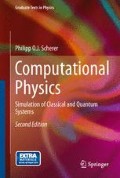Abstract
In this chapter we study Markovian discrete time random walk models. In one dimension the position of the walker after n steps approaches a Gaussian distribution. This can be checked in a computer experiment. A 3-dimensional random walk provides a simple statistical model for the configuration of a biopolymer (freely jointed chain). We generate random structures and calculate the gyration tensor, an experimentally observable quantity, which gives information on the shape of a polymer. Simulation of the dynamics is simplified if the fixed length segments of the freely jointed chain are replaced by Hookean springs. This is utilized in a computer experiment to study the dependence of the polymer extension on an applied external force (entropic elasticity). The random motion of a heavy particle in a bath of light particles (Brownian motion) can be described by Langevin dynamics, which replace the collisions with the light particles by an average friction force proportional to the velocity and a randomly fluctuating force with zero mean and infinitely short correlation time. In a computer experiment we study Brownian motion in a harmonic potential.
Access this chapter
Tax calculation will be finalised at checkout
Purchases are for personal use only
Notes
- 1.
Different steps are independent.
- 2.
A special case of the more general continuous time random walk with a waiting time distribution of P(τ)=δ(τ−Δt).
- 3.
General random walk processes are characterized by a distribution function P(R,R′). Here we consider only correlated processes for which P(R,R′)=P(R′−R).
- 4.
For a 1-dimensional polymer \(\overline{\cos\theta_{i}}=0\) and \(\overline{(\cos\theta_{i})^{2}}=1\). In two dimensions \(\overline{\cos\theta_{i}}=\frac{1}{\pi}\int_{0}^{\pi}\cos\theta\,d\theta=0\) and \(\overline{(\cos\theta_{i})^{2}}=\frac{1}{\pi}\int_{0}^{\pi}\cos^{2}\theta\, d\theta=\frac{1}{2}\). To include these cases the factor 3 in the exponent of (16.33) should be replaced by the dimension d.
References
R. Brown, Philos. Mag. 4, 161 (1828)
A. Einstein, Ann. Phys. 17, 549 (1905)
A. Einstein, Investigations on the Theory of Brownian Movement (Dover, New York, 1956)
A.A. Markov, Theory of Algorithms [Translated by Jacques J. Schorr-Kon and PST staff] Imprint Moscow, Academy of Sciences of the USSR, 1954 [Jerusalem, Israel Program for Scientific Translations, 1961; available from Office of Technical Services, United States Department of Commerce] Added t.p. in Russian Translation of Works of the Mathematical Institute, Academy of Sciences of the USSR, v. 42. Original title: Teoriya algorifmov. [QA248.M2943 Dartmouth College library. U.S. Dept. of Commerce, Office of Technical Services, number OTS 60-51085] (1954)
A.A. Markov, Extension of the limit theorems of probability theory to a sum of variables connected in a chain, in Dynamic Probabilistic Systems, vol. 1: Markov Chains (Wiley, New York, 1971), reprinted in Appendix B of Howard, R.
W.L. Mattice, U.W. Suter, Conformational Theory of Large Molecules (Wiley-Interscience, New York, 1994). ISBN 0-471-84338-5
K. Pearson, The problem of the random walk. Nature 72, 294 (1905)
G. Schaftenaar, J.H. Noordik, J. Comput.-Aided Mol. Des. 14, 123 (2000)
Author information
Authors and Affiliations
Rights and permissions
Copyright information
© 2013 Springer International Publishing Switzerland
About this chapter
Cite this chapter
Scherer, P.O.J. (2013). Random Walk and Brownian Motion. In: Computational Physics. Graduate Texts in Physics. Springer, Heidelberg. https://doi.org/10.1007/978-3-319-00401-3_16
Download citation
DOI: https://doi.org/10.1007/978-3-319-00401-3_16
Publisher Name: Springer, Heidelberg
Print ISBN: 978-3-319-00400-6
Online ISBN: 978-3-319-00401-3
eBook Packages: Physics and AstronomyPhysics and Astronomy (R0)

